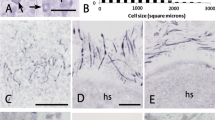Abstract
We previously found that Merkel cells (MCs) of the rat and monkey show a strong immunoreaction of the α-subunit of Gq protein. The Gαq-subunit isoform activates isozymes of phospholipase C-β (PLC-β), which produces inositol-(1,4,5)-triphosphate (IP3) which mobilizes intracellular Ca++ from calcium stores via IP3 receptors. Glutamate and adenosine triphosphate (ATP), which are candidates for neurotransmitters in Merkel endings, are known to couple to Gαq. Although MCs showed positive immunoreactions of metabotropic glutamate receptor 5 (mGluR5) in our preliminary study, these cells were not reactive to all antibodies to PLC-β isozymes. We, therefore, reinvestigated immunohistochemical affinities to MCs of antibodies to PLC-β isozymes and mGluRs using frozen sections of rat sinus hair follicles that were briefly postfixed in formaldehyde. We also studied the immunohistochemical expressions of P2Y receptors for ATP and IP3 receptor subtypes using similar sections. Merkel cells showed positive immunoreactions of PLC-β1 and mGluR5. It was also found that MCs show positive immunoreactions of P2Y2, IP3R-I, and IP3R-II receptors. These results suggest that the Gαq isoform in MCs couples to both the P2Y2 receptor and mGluR5 and regulates the intracellular Ca++ concentration via the PLC-β–IP3 cascade.






Similar content being viewed by others
References
Berridge MJ (1993) Inositol triphosphate and calcium signaling. Nature 361:315–325
Burnstock G, Wood JN (1996) Purinergic receptors: their role in nociception and primary afferent neurotransmission. Curr Opin Neurobiol 6:526–532
Chan E, Yung WH, Baumann KI (1994) ATP increases intracellular calcium levels in Merkel cells of an isolated rat sinus hair preparation. J Physiol 475.P:148–149
Conklin BR, Bourne HR (1993) Structural elements of Gα subunits that interact with Gβγ, receptors, and effectors. Cell 73:631–641
Cook SP, Vulchanova L, Hargreaves KM, Elde R, McCleskey EW (1997) Distinct ATP receptors on pain-sensing and stretch-sensing neurons. Nature 387:505–508
Fagan BM, Cahusac PBM (2001) Evidence for glutamate receptor mediated transmission at mechanoreceptors in the skin. Neuroreport 12:341–347
Fallon JB, Maroto R, Hamill OP, Proske U (2002) ATP suppresses activity in slowly adapting but not rapidly adapting mechanoreceptors in toad skin. Neuroreport 13:1443–1446
Gottschaldt K-M, Vahle-Hinz C (1982) Evidence against transmitter function of met-enkephalin and chemosynaptic impulse generation in "Merkel cell" mechanoreceptors. Exp Brain Res 45:459–463
Hartschuh W, Weihe E, Reinecke M (1986) The Merkel cell. In: Bereiter-Hahn J, Matoltsy AG, Richards KS (eds) Biology of the integument, vol 2. Springer, Berlin Heidelberg New York, pp 606–620
Hezareh M, Journot L, Bepoldin L, Schlegel W, Rawlings SR (1996) PACAP/VIP receptor subtypes, signal transducers, and effectors in pituitary cells. Ann N Y Acad Sci 805:315–327
Hoyer D, Martin G (1997) 5-HT receptor classification and nomenclature: towards a harmonization with the human genome. Neuropharmacology 36:419–428
Iggo A, Findlater GS (1984) A review of Merkel cell mechanisms. In: Hamann W, Iggo A (eds) Sensory receptor mechanisms. World Scientific, Singapore, pp 117–131
Kim D, Jun KS, Lee SB, Kang N-G, Min DS, Kim Y-H, Ryu SH, Suh P-G, Shin H-S (1997) Phospholipase C isozymes selectively couple to specific neurotransmitter receptors. Nature 389:290–293
Krause JE, Takeda Y, Hershey AD (1992) Structure, functions, and mechanisms of substance P receptor action. J Invest Dermatol 98:2S–7S
Lee C-W, Lee K-H, Lee SB, Park D, Rhee SG (1994) Regulation of phospholipase C-β4 by ribonucleotides and the α subunit of Gq. J Biol Chem 269:25335–25338
Merkel F (1875) Tastzellen und Tastkörperchen bei den Hausthieren und beim Menschen. Arch Mikrosk Anat 11:636–652
Mills LR, Diamond J (1995) Merkel cells are not the mechanosensory transducers in the touch dome of the rat. J Neurocytol 24:117–134
Morris AJ, Malbon CC (1999) Physiological regulation of G protein-linked signaling. Physiol Rev 79:1373–1430
Munger BL (1975) Cytology of mechanoreceptors in oral mucosa and facial skin of the Rhesus monkey. In: Tower DB (ed) The nervous system, vol 1. The basic neurosciences. Raven, New York, pp 71–79
Nakamura F, Strittmatter SM (1996) P2Y1 purinergic receptors in sensory neurons: contribution to touch-induced impulse generation. Proc Natl Acad Sci U S A 93:10465–10470
Neer EJ (1995) Heterotrimeric G proteins: organizers of transmembrane signals. Cell 80:249–257
Ogawa H (1996) The Merkel cell as a possible mechanoreceptor cell. Prog Neurobiol 49:317–334
Pin J-P, Duvoisin R (1995) The metabotropic glutamate receptors: structure and functions. Neuropharmacology 34:1–26
Ralevic V, Burnstock G (1998) Receptors for purines and pyrimidines. Pharmacol Rev 50:413–475
Rhee SG, Bae YS (1997) Regulation of phosphoinositide-specific phospholipase C isozymes. J Biol Chem 272:15045–15048
Senock SS, Genever PG, Cahusac PMB, Baumann KI (2003) Glutamate receptor-like immunoreactivity in rat vibrissal Merkel cells. In: Baumann KI, Halata Z, Moll I (eds) The Merkel cell. Structure, development, function, and Merkel cell carcinoma. Elsevier, Amsterdam, pp 157–162
Sternweis PC, Smrcka AV (1993) G proteins in signal transduction: the regulation of phospholipase C. Ciba Found Symp 176:98–111
Tachibana T (1995) The Merkel cell: recent findings and unresolved problems. Arch Histol Cytol 58:379–396
Tachibana T, Nawa T (2002) Recent progress in studies on Merkel cell biology. Anat Sci Int 77:26–33
Tachibana T, Nawa T (2003) Localization of signal transduction proteins in the Merkel cell axon complex. In: Baumann KI, Halata Z, Moll I (eds) The Merkel cell. Structure, development, function, and Merkel cell carcinoma. Elsevier, Amsterdam, pp 141–148
Tachibana T, Endoh M, Nawa T (2001) Immunohistochemical expression of G protein alpha-subunit isoforms in rat and monkey Merkel cell–neurite complexes. Histochem Cell Biol 116:205–213
Acknowledgements
This study was in part supported by a grant-in-aid for scientific research (number 14570024) and a grant-in-aid for Open Research Project from the Ministry of Education, Science and Culture of Japan.
Author information
Authors and Affiliations
Corresponding author
Rights and permissions
About this article
Cite this article
Tachibana, T., Endoh, M., Kumakami, R. et al. Immunohistochemical expressions of mGluR5, P2Y2 receptor, PLC-β1, and IP3R-I and -II in Merkel cells in rat sinus hair follicles. Histochem Cell Biol 120, 13–21 (2003). https://doi.org/10.1007/s00418-003-0540-5
Accepted:
Published:
Issue Date:
DOI: https://doi.org/10.1007/s00418-003-0540-5




